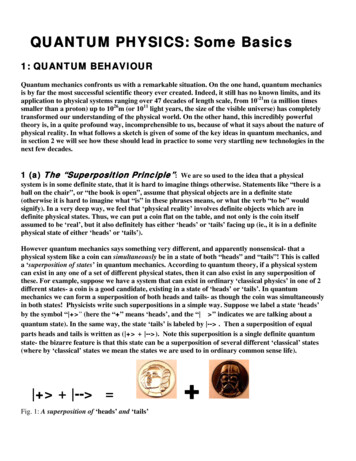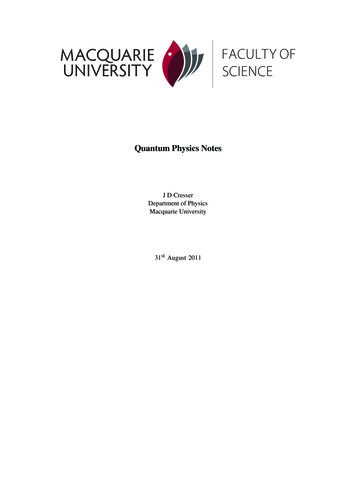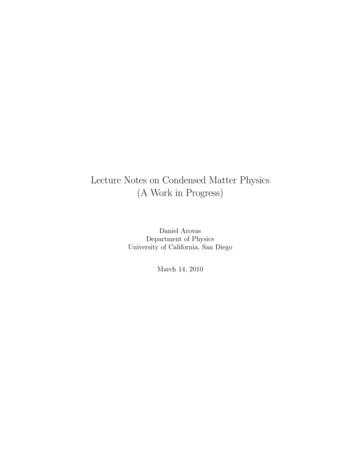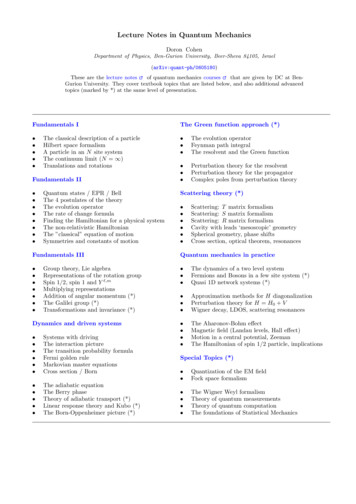
Transcription
QUANTUM PHYSICS: Some Basics1: QUANTUM BEHAVIOURQuantum mechanics confronts us with a remarkable situation. On the one hand, quantum mechanicsis by far the most successful scientific theory ever created. Indeed, it still has no known limits, and itsapplication to physical systems ranging over 47 decades of length scale, from 10-21m (a million timessmaller than a proton) up to 1026m (or 1011 light years, the size of the visible universe) has completelytransformed our understanding of the physical world. On the other hand, this incredibly powerfultheory is, in a quite profound way, incomprehensible to us, because of what it says about the nature ofphysical reality. In what follows a sketch is given of some of the key ideas in quantum mechanics, andin section 2 we will see how these should lead in practice to some very startling new technologies in thenext few decades.1 (a) The “Superposition Principle”: We are so used to the idea that a physicalsystem is in some definite state, that it is hard to imagine things otherwise. Statements like “there is aball on the chair”, or “the book is open”, assume that physical objects are in a definite state(otherwise it is hard to imagine what “is” in these phrases means, or what the verb “to be” wouldsignify). In a very deep way, we feel that ‘physical reality’ involves definite objects which are indefinite physical states. Thus, we can put a coin flat on the table, and not only is the coin itselfassumed to be ‘real’, but it also definitely has either ‘heads’ or ‘tails’ facing up (ie., it is in a definitephysical state of either ‘heads’ or ‘tails’).However quantum mechanics says something very different, and apparently nonsensical- that aphysical system like a coin can simultaneously be in a state of both “heads” and “tails”! This is calleda ‘superposition of states’ in quantum mechanics. According to quantum theory, if a physical systemcan exist in any one of a set of different physical states, then it can also exist in any superposition ofthese. For example, suppose we have a system that can exist in ordinary ‘classical physics’ in one of 2different states- a coin is a good candidate, existing in a state of ‘heads’ or ‘tails’. In quantummechanics we can form a superposition of both heads and tails- as though the coin was simultaneouslyin both states! Physicists write such superpositions in a simple way. Suppose we label a state ‘heads’by the symbol “ ” (here the “ ” means ‘heads’, and the “ ” indicates we are talking about aquantum state). In the same way, the state ‘tails’ is labeled by -- . Then a superposition of equalparts heads and tails is written as ( -- ). Note this superposition is a single definite quantumstate- the bizarre feature is that this state can be a superposition of several different ‘classical’ states(where by ‘classical’ states we mean the states we are used to in ordinary common sense life). -- Fig. 1: A superposition of ‘heads’ and ‘tails’
The difficulties attending such superpositions were highlighted in 1935, when Schrodinger describedhow according to quantum mechanics one might put a cat (now called “Schrodinger’s Cat”)simultaneously into a superposition of “live” and “dead” states. Schrodinger’s argument was intendedto show that bizarre superpositions of radically different classical physical states were logicallypossible in quantum mechanics. For many years most physicists took Schrodinger’s Cat to be areductio ad absurdum (as did Schrodinger), and assumed that macroscopic quantum states must insome way be absolutely forbidden. However, starting in 1979 with theoretical work of Leggett andcollaborators, it was shown that macroscopic quantum superpositions could indeed exist underspecial circumstances (although a superposition of live and dead cats is probably a fantasy), and theywere first prepared experimentally, in superconductors at low temperature, in 2003. They areexpected to be crucial to any future ‘quantum technology’.1(b) Quantum “Entanglement”: The idea of superposition is bad enough for ourcommon sense views, but it is certainly not the most bizarre feature of quantum mechanics. Thishonour falls to what is called ‘entanglement’. Consider TWO coins- let’s call them coin A and coin Band suppose we correlate their behaviour so that, eg., they must always have opposite states (NB: tophysically correlate them can be done in various ways- in fact any interaction between them will, inquantum mechanics, lead to some kind of correlation). Now there are 2 possible ways for the coinstates to be oppositely oriented. One is to have coin A as heads, and coin B as tails- this state would bewritten as -- . However we could also have coin A as tails, and coin B as heads- this state would bewritten as -- . Common sense tells us that we must have one situation or the other. However inquantum mechanics, again, we can have a superposition of the two possibilities- giving a state which iswritten as ( -- -- ); see figure below: -- -- Fig. 2: An entangled pair of coin states, as described in text.Now the startling thing is that in such a superposition, we can attribute no physical state to either of thecoins separately - only the PAIR of coins is in a definite state. Thus when 2 physical systems are in anentangled state, the physical state of one of the systems on its own does not exist- only the ‘pair state’is physical real. We see that entanglement demands a radical revision of our notion of ‘reality’. Theconflict between quantum notions of reality, and very deeply-entrenched common sense intuitions, iscertainly the most difficult philosophical problem raised by modern physics. Many have simplyrefused to accept such strange ideas. The most notable objections came from Einstein: starting fromthe famous ‘Einstein-Podolsky-Rosen’ paradox (1935), he argued that quantum mechanics must beincomplete, by showing that entanglement led to apparently nonsensical experimental consequences.To the end of their lives, Einstein and Schrodinger never accepted that physical reality could be thisway. However, experiments in the last 25 years have not only confirmed entanglement in the lab, butshown it can be used as a tool to do incredible things - discussed in section 2 below. Nowadays one
talks of entanglement as a new ‘resource’ (meaning, amongst other things, that it can be used todevelop new technologies- see below).Fig. 3: Two of Walt Disney’s images of the power of modern quantum physics, embodied (LEFT) in amalevolent genie towering over the fisherman, or (RIGHT) in a benevolent genie, whose power isharnessed for the good of all (from ‘Our Friend the Atom’ (1964)).Walt Disney summed up, in his remarkable film “Our Friend the Atom”, the 2-sided face of quantummechanics that we now perceive, by the analogy of an Arabian genie. On the one hand, a theory ofapparently limitless scope and power, quite unprecedented in previous human history, and on theother hand, an interpretation and an associated ontology that seem mysterious & paradoxical.Nobody can truly claim to understand quantum theory, and some of its greatest practitioners feelinstinctively that it must somehow be flawed or incomplete, despite its unparalleled success. Othersargue that it is here to stay, and the flaw is in our own intuitions of reality. Whatever one may thinkabout these essentially philosophical issues, they can no longer be ignored- in the next few decades,macroscopic devices will be built which depend essentially on entanglement and superposition fortheir operation, bringing uniquely quantum-mechanical phenomena into our everyday world.1 (c) Key Features of Quantum Mechanics: As indicated above, quantummechanics has been applied to virtually every physical system we know, with extraordinarilyrevealing consequences. This has happened not just in physics but also in chemistry and biology- thestunning changes in chemistry and biology, with the unraveling of the genetic code and our nowessentially complete understanding of chemistry, stem entirely from the development of quantummechanics. With some hindsight we can see that the 1st stage of what is often called the ‘quantumrevolution’ is now more or less complete- this consisted in the unraveling of already known physicalphenomena, and the exploration of new phenomena revealed by quantum mechanics, in a mostlypassive navigation of the natural world on all length scales. The seeds of the 2nd stage were sown manyyears ago, with the use of quantum mechanics to develop fundamentally new physical systems, notpresent in Nature. Well-known examples of this are in devices such as transistors and lasers, now at
the heart of a large part of the modern electronics industry. But such devices hardly use the fullpotential of quantum mechanics, embodied in the ideas of superposition and entanglement. Only noware we on the threshold of huge changes, as we begin to learn how to do this. Most of the comingdevelopments are labeled under the heading of ‘Quantum Nanoscience’, with applications comingunder the umbrella of ‘Quantum NanoTechnology’. In the rest of this section I describe some of therelevant quantum ideas underlying these new developments; the next section (section 2) describessome of the applications being envisaged for a future quantum nanotechnology.(i) DISCRETE QUANTUM STATES: In classical physics we are accustomed to a continuum ofpossible states for a physical system- we imagine, eg., a particle passing continuously from oneposition to another along some classical trajectory, and such continuous change now seems quite anatural idea, notwithstanding the old objections and paradoxes of Zeno of Elea. However, asalready hinted above, a quantum system can often only exist in one or more of a discrete set ofstates. This key feature of quantum systems arises whenever they are confined in some finiteregion of space. Such confinement happens when the system in question is subject to some forceattracting it towards that region. Physicists represent this pictorially by defining a ‘potential’which represents the energy of the system coming from its interaction with the force- an attractiveforce creates a ‘potential well’. Thus, eg., in a Hydrogen atom, a negatively charged electron isattracted towards the positively charged proton nucleus, and classically it would simply orbit theproton (until it radiated energy away, and it would then ‘fall down’ the potential well to thecentre, ie., collapse into the proton!).However the quantum electron can only go into certain discrete states - each state has a differentenergy, and so we talk about ‘energy levels’. Each level refers to a different possible quantumstate. There is always a lowest state of all, which is called the ‘ground state’; if the electron settlesinto this state, it can lose no more energy. States of higher energy than the ground state are called‘excited states’. This is a perfectly general feature of a quantum system localized in a potentialwell- the example in the figure not only shows the energy levels, but also how a particle in any ofthese states spreads out in space inside the potential well:Fig 4: Bound states in a potential well. LEFT: the well, with energy levels shown as horizontal lines.RIGHT: the probability to find the particle at some position relative to the bottom of the well (thelowest energy position), for the lowest ground state (n 0) and the first few excited states.
The electron in an atom can make transitions between the different states, but to do so it mustabsorb or emit the energy difference- which it does by absorbing or emitting a photon. Since onlycertain values of this energy difference are possible, only certain energies of the photon arepossible. It is this result which is responsible for the colours of objects- photons of differentenergies are associated with different colours, and atoms or molecules from which some specificmaterial is made will only emit light at specific energies, which correspond to the colour of thematerial. In fluorescent materials, the atoms absorb radiation at some time (putting the electronsinto excited states), and then much later they radiate photons (so that the electrons decay backdown to lower states), so that the material seems to glow with no apparent external stimulusacting.One can now, with the tools of nanofabrication, make very small artificial potential wells forelectrons in semiconducting materials- small regions where the electrons have lower energy- andconfine one or a few electrons in these wells. These ‘quantum wells’ (also called ‘quantum dots’when the region is really small) trap electrons like artificial atoms, but they can be made in a widevariety of shapes and sizes. One can also connect these wells or dots with ‘quantum wires’ (ie.,extremely small potential wells in the shape of a channel), and in the wires one can put ‘quantumgates’ (ie., potential barriers which can be raised or lowered, using external electric fields). Inother words, one can make electric components like transistors, or even complete circuits, at thenanoscale, with only a few electrons involved. We thus already have in place one of the ingredientsrequired to make electronic devices at the molecular scale.One other thing is useful to understand. As one makes the confining region smaller, both theenergies of the confined states, and the energy differences between the different states (one talks ofthe here of the ‘energy level splittings’), increase rather quickly. At the length scale of atoms, theenergies involved are those associated with chemical reactions (which are just transitions betweenenergy levels inside one or several atoms). But if we look at the much smaller atomic nucleus(which is a collections of protons and neutrons bound together by the so-called ‘strong’ force), theenergies are huge- transitions between nuclear levels are associated with thermonuclear processes(which drive the stars, as well as thermonuclear weapons). On the other hand particles inside alarge volume hardly show quantum properties at all- the energy levels are so closely packedtogether that the system behaves as though there is a continuum of possible states.(ii) BOSONS & FERMIONS: One can still talk about particles in quantum mechanics, although theyaren’t in general localised at a particular point in space (indeed, if left free to move, they morenaturally spread out into a wave-like state, propagating though space). However it turns out thatall particles in Nature must be one of 2 kinds. One kind is called a ‘boson’ (after the Indianphysicist S Bose); these particles have a natural tendency to all go into the same quantummechanical state, preferably the ground state (a process called ‘Bose-Einstein condensation’, orBEC- see (v) below). Bosons are responsible for the forces between the particles of matter, ie.,between fermions- the best-known example is the photon, which is exchanged between chargedparticles and causes attraction between unlike charges and repulsion between like charges.
Fig 5: How bosons and fermions will fill up quantum states differently (see text)On the other hand one has ‘fermions’, which can never go into the same quantum state- so that acollection of fermions must all go into different states. All particles from which ordinary matter ismade- electrons, protons, neutrons, etc.- are fermions. This fact is crucial to the structure ofmatter. In an atom containing several electrons, each electron will go into a different state, fillingup higher and higher energy levels. Since each one of these states is different, and the electrons ineach one are distributed differently in space, atoms having different numbers of electrons havedifferent shapes and behave differently. Thus we get the chemical elements, corresponding todifferent atoms. If instead matter were made from bosons, it would immediately collapse, as all theelectrons in all the atoms dropped into the same lowest-energy state close to the atomic nuclei- andall atoms would end up looking all the same.Fig 6: Different electronic states in an atom- the pictures show how the electron is distributedaround the nucleus in the different states. The lowest energy state (sometimes called the ‘groundstate’ is the one shown at top left.It is interesting to look at the shapes of the different electronic states in an atom (figure above).The electron distribution projects out from the atom in different lobe-shaped clouds, depending onwhich state we are looking at. It is this that is responsible for the existence of directed bondsbetween atoms. If 2 atoms approach each other, the electrons can arrange themselves amongst thedifferent states in such a way that the 2 atoms attract, with electrons on the 2 atoms overlapping to
some extent between the different electron lobes. Some of the lobes then orient themselves into aline between the 2 atoms- these are the bonds (we shall see a little later that this happens becauseof something called ‘quantum tunneling’). It is remarkable that the original ideas of Democritus,concerning the shapes of different ‘atomoi’, which then link together in various ways, should findtheir final justification in quantum theory.(iii)SPIN: In the same way as a spinning ball or the spinning earth, even elementary particles likeelectrons or protons can have ‘spin’. In the same way as we have seen above, a given particle has afinite number of discrete spin states- the simplest systems, like an electron, only have 2 spinsstates. These spin states are associated with circulating currents, and the circulating currentsgenerate a magnetic field- in this way all atoms having a non-zero spin or angular momentumgenerate a magnetic field. This field is small, unless one is very close to the atom; however, if allthe atoms in a solid align their spins in the same direction, the combined fields from all of themcan be quite large- this is how we get a magnetic material. This kind of spin ordering can also bedone at the nanoscale, most conveniently in nanoscale magnetic molecules- many thousands ofdifferent molecules of this kind have been produced.Fig 7: A 2-state spin system- the 2 states behave as though the have circulating currents (in oppositedirections), which generate small magnetic fields (which are either up or down)Note that spins are also very sensitive to any external magnetic field, which strongly affects theirdynamics, causing the spin axis to turn in various ways. This means that by using magnetic fields,or applied electromagnetic waves, we can manipulate spins in many ways. Because of theirsensitivity to fields, spins are also very useful probes of any ambient fields. The use of spin and ofmagnetism is of course ubiquitous in modern technology, from hard discs and CD’s to MRIscanners (in the former, information is stored in the orientation of very small magnets; and in thelatter, nuclear spins in the body sense the weak fields from the local chemical environment,allowing a detailed map of the body to be produced).One other useful thing about spin to note is that it is a kind of angular momentum, and so its totalvalue in a physical process normally cannot change (we say that it is a ‘conserved’ quantity, in thesame way as total energy is conserved). This allows us to very easily prepare entangled pairs ofspins. Recall that when we produced an entangled pair of coins, we asked that they have oppositestates. For spins this is easy- we can produce a pair of spins whose total angular momentum iszero, and then they must be opposite. Then the analogy with the coins is quite precise, if weimagine that ‘spin up’ corresponds to ‘heads’, and ‘spin down’ to ‘tails’ (cf, section 1(b) above).The entangled state ( -- -- ) then corresponds to an equal superposition of “up, down”and “down, up” states.
(iv) PHOTONS & FIELDS: We are all familiar with electromagnetic waves- depending on theirwavelength, these can be radio waves, microwaves, light waves, UV, X-rays, or gamma rays. Theseare all wavelike excitations of the electromagnetic (EM) field, predicted in Maxwell’s 19th centuryclassical theory (which itself unified our understanding of electric and magnetic phenomena, andled to the first technological revolution of the early 20th century where machines began to replacedby electromagnetic devices for lighting, heating and power, communication, etc.). In classicalphysics this EM field is a continuous field, extending throughout space. In quantum mechanics theexcitations of the EM field are bosonic particles, the so-called light quanta called photons. Wehave seen already that these can be emitted or absorbed by atoms, when the electrons maketransitions between different states; and that they are responsible for the forces between charges.A typical EM wave is made from huge numbers of photons in different states, so many that thewave appears continuous rather than particulate.Waves themselves have fascinating behaviour- one of the most striking is interference, when wavesfrom 2 different sources meet, and we see them either adding (constructive interference) orcanceling (destructive interference) depending on where one is in space. A simple way to show thisis via the famous ‘2-slit interference’ experiment (Fig. 19 below, centre & right), in which light ispassed through 2 slits A and B, which each act as a source for the transmitted light, which thenarrives on a screen C.Fig 8: Wave properties of light. LEFT: interference between waves from 2 sources. CENTRE: the 2slit interference experiment. RIGHT: Experimental 2-slit interference from a green light source.The quantum nature of light reveals itself if we lower the light intensity, until only a few photonsare passing through the slits each second- no longer do we see a continuous wave, but instead, thelight arrives in distinct ‘packages’ on the screen- these are the photons. Amazingly, as one lets thephotons accumulate on the screen, the wave interference pattern reappears- the photons onlyarrive on the screen in regions of constructive wave interference! This is sometimes called ‘waveparticle duality’.
Fig. 9: Quantum properties of light/photons. LEFT: How the 2-slit interference pattern develops intime, as more and more photons arrive. RIGHT: Decay of zero-spin positronium into 2 photonsmoving in opposite directions. 2 final states are possible- one with helicities m 1, -1 for photonsmoving up/down, and the other with the opposite helicities, ie., m -1, 1 respectively.Much more dramatic quantum effects are seen when we correlate pairs of photons. Theexample shown in Fig. 9 at right is very much the same as the example of 2 entangled spins justdiscussed above, in that photons also have a kind of ‘spin’ (called ‘helicity’ in the case of photons).One can produce a pair of photons with opposite helicity by annihilating an electron-positron pair(when bound together these are called ‘positronium’). If the initial angular momentum of thepositronium is zero, then the total helicity of the photons must also be zero. Fig. 9 shows the 2possible outcomes. One is a state which we will call -- (referring to the positive and negativehelicities respectively); but by now the reader will realize that a legitimate quantum state can beformed by superposing this state with the other possible decay product of the annihilation, ie.,with the state -- (in which it is now the negative helicity state that is moving upward). Thus,we can now form the entangled photon state ( -- -- ). Interestingly, it was with suchstates that the experimental proof of entanglement was first given.In the last 4 decades we have learnt to manipulate photon states with exquisite control. By puttinga large number of photons in exactly the same quantum state (where they are happy to go, beingbosons), we get what is called coherent light- this is what is produced by a laser. Photons in thisBose-Einstein (BEC) condensed state are remarkably stable, making laser light extremely useful.With combinations of lasers, entangled photon states, and atoms, quite extraordinary things havebeen done in recent years, which will be central to future nanoscience- we will see this in section 2below.(v) BOSE-EINSTEIN CONDENSATION (BEC): We have already seen how bosons like photons canall be put into the same state, a ‘coherent’ or ‘BEC’ state. Since ordinary matter is made fromparticles that are all fermions, it would seem at first glance impossible to have a ‘coherent state’of, say, electrons, in which they all go into the same state. However, if one combines 2 fermions
into a pair, then they will for many purposes behave like a boson. In metallic systems this canhappen- there is a rather weak attraction between electrons which is mediated by the quanta ofsound waves (called ‘phonons’), which at low temperatures allows pairs to form- these can thenform a coherent or ‘BEC’ state in which all pairs are in exactly the same state. Thus in a certainsense we can make the analogue of a coherent photon state, but now with electrons in a metallicconductor. The result, when the metal goes into this state, is a quite dramatic change in itsproperties - it becomes a superconductor. Superconductors show remarkable behaviour- forexample, because the electrons are constrained to all do the same thing, they can flow with noresistance (so we can set a current flowing in a superconducting circuit, and it will continue tocirculate forever). Properties like this make superconductors extremely useful in certaintechnological applications. One of the most remarkable of these is called the ‘SQUID’ (from“Superconducting Quantum Interference Device”); it is essentially an analogue of the 2-slitinterference system for photons that we just described above. Electrons passing via 2 differentpaths recombine (see Fig. 10, below left), and the resulting current flow is shown at right. One getsthe same interference as with photons passing through 2 slits, except here the interference patterncan be manipulated with a magnetic field- this is because the electrons, being charged, feel themagnetic field. Because all the electrons are behaving in the same way, their response to themagnetic field is a coherent response from all of them, making the SQUID fantastically sensitive tosmall changes in external magnetic field:Fig 10: The ‘SQUID’. LEFT: schematic SQUID- electrons come in at left, travel through the 2arms, via the insulating ‘Josephson junctions’ a and b, and out to the right. RIGHT: The currentcoming out of the SQUID as a function of the magnetic field through the SQUID.We shall see a lot more of the SQUID below, in our discussions of future quantumnanotechnology. Note that one can do the same tricks with neutral fermions (ie., not possessing acharge, like electrons), and one then gets superfluid behaviour. An example is provided byHelium; this is a gas until very low temperatures, when it becomes liquid, and then superfluid- atwhich point it flows through the tiniest of holes (down almost to atomic scales) with no viscosityleading to quite spectacular behaviour at times!(vi) QUANTUM TUNNELING: Suppose we have a quantum system which is attracted towards somepoint is space- so there is a potential well around this point- but that if it moves farther away, it isrepelled.
Fig. 11(a)Fig. 11(b)Fig 11(a): A ‘metastable well’ potential, in which a particle is prevented by an energy barrier(of height ΔU) from moving off to the right- but in the right region its energy will be still lower.Fig 11(b): The ‘2-well’ potential. In the left picture we see the 2 states localized in the left and rightwells, which have different energies (the left well state has higher energy). In the right picturethey have equal energy, but now tunneling allows them to form ‘superpositions’ of the left andright well state- the ground state is shown in black, and the excited state is shown in light grey.This is precisely what happens in, eg., an atomic nucleus- nuclear particles like protons areattracted very strongly to each other by the ‘strong force’, but this force is very short-ranged, andif they move apart, there is a residual repulsive electric force between them, because they have likepositive electric charges. In this way one ends up with the kind of ‘metastable well’ potentialshown above left (Fig 11(a)).Now in classical physics, a particle trapped in the well cannot escape unless it is given enoughenergy to go over the barrier, by ‘kicking it’ with some external force- otherwise it will justoscillate with some frequency ωP inside the potential well. Quantum mechanically, there will beenergy levels corresponding to states trapped in the well- however, quantum mechanics also tellsus that these states can ‘quantum tunnel’ through the barrier, and escape to the right, evenwithout being kicked. This is why heavy nuclei are unstable, and subject to radioactive decayparticles can slowly tunnel out, and once they do, they are rapidly accelerated away by the strongrepulsive force outside the nucleus (ie., they ‘roll down’ the potential slope on the right). The fastoutcoming particles from a nucleus can cause a lot of ‘radiation damage’, blasting molecules andatoms apart when they collide with them- this is why radioactive materials are dangerous.Another interesting example of quantum tunneling is in the STM discussed at the beginning of thisdocument (intro to section 1), in which electrons tunnel from the very fine tip, across a small gap(of width only a few atom diameters in size) into whatever the STM is looking at. The tunnelingcurrent (ie., the number of electrons tunneling across per second) is exquisitely sensitive to howfar the electrons have to tunnel, so that by moving the tip just above the surface one is looking at,a very detailed topographic map can be made- as we saw in the document on ClassicalNanoscience.A remarkable consequence of tunneling arises if we allo
Fig. 3: Two of Walt Disney’s images of the power of modern quantum physics, embodied (LEFT) in a malevolent genie towering over the fisherman, or (RIGHT) in a benevolent genie, whose power is harnessed for the good of all (from ‘Our Friend the Atom’ (1964)). Walt Disney summed up, in his remarkabl










